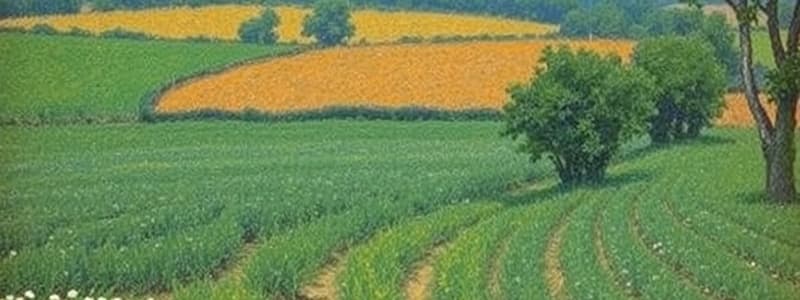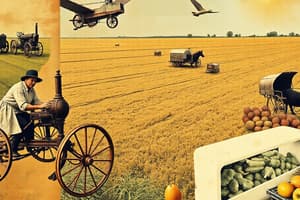Podcast
Questions and Answers
What is the primary goal of livestock management?
What is the primary goal of livestock management?
- To care and feed farm animals for various production purposes (correct)
- To restrict animal breeding to increase profits
- To minimize farm costs through automation
- To eliminate environmental impacts of farming
Which of the following is a significant environmental impact of agriculture?
Which of the following is a significant environmental impact of agriculture?
- Enhanced local food security
- Reduction of greenhouse gases from livestock
- Increased biodiversity in farming systems
- Soil erosion and pollution of water sources (correct)
Which modern agricultural trend primarily focuses on using technology to optimize resource use?
Which modern agricultural trend primarily focuses on using technology to optimize resource use?
- Agroforestry
- Organic agriculture
- Sustainable agriculture
- Precision agriculture (correct)
What is a defining characteristic of genetically modified organisms (GMOs)?
What is a defining characteristic of genetically modified organisms (GMOs)?
What does vertical farming aim to achieve?
What does vertical farming aim to achieve?
What significant change marked the transition from nomadic lifestyles to settled agricultural communities?
What significant change marked the transition from nomadic lifestyles to settled agricultural communities?
Which type of agriculture primarily serves the needs of the farmer's family or community?
Which type of agriculture primarily serves the needs of the farmer's family or community?
What is one of the main benefits of crop rotation in agricultural practices?
What is one of the main benefits of crop rotation in agricultural practices?
Which agricultural practice involves the application of nutrients to the soil?
Which agricultural practice involves the application of nutrients to the soil?
What distinguishes extensive agriculture from intensive agriculture?
What distinguishes extensive agriculture from intensive agriculture?
How does commercial agriculture primarily differ from subsistence agriculture?
How does commercial agriculture primarily differ from subsistence agriculture?
Which of the following practices is NOT commonly associated with agricultural land management?
Which of the following practices is NOT commonly associated with agricultural land management?
What role does irrigation play in agricultural practices?
What role does irrigation play in agricultural practices?
Flashcards
Neolithic Revolution
Neolithic Revolution
The period of time roughly 10,000-12,000 years ago when humans transitioned from nomadic hunter-gatherer lifestyles to settled agricultural communities.
Domestication
Domestication
The practice of domesticating plants and animals to provide a stable and predictable food source.
Subsistence Agriculture
Subsistence Agriculture
A type of agriculture where farmers produce enough food for their family or immediate community, with little surplus.
Commercial Agriculture
Commercial Agriculture
Signup and view all the flashcards
Crop Rotation
Crop Rotation
Signup and view all the flashcards
Irrigation
Irrigation
Signup and view all the flashcards
Fertilization
Fertilization
Signup and view all the flashcards
Pest and Disease Management
Pest and Disease Management
Signup and view all the flashcards
Livestock Management
Livestock Management
Signup and view all the flashcards
Precision Agriculture
Precision Agriculture
Signup and view all the flashcards
Genetically Modified Organisms (GMOs)
Genetically Modified Organisms (GMOs)
Signup and view all the flashcards
Organic Agriculture
Organic Agriculture
Signup and view all the flashcards
Sustainable Agriculture
Sustainable Agriculture
Signup and view all the flashcards
Study Notes
History of Agriculture
- Agriculture originated during the Neolithic Revolution, 10,000-12,000 years ago.
- This involved a shift from nomadic hunter-gatherer life to settled agricultural communities.
- Domestication of plants and animals provided a more stable food source.
- Early agricultural practices used simple tools, evolving over time.
- Agriculture led to population growth and the development of villages, eventually complex societies and civilizations.
Types of Agriculture
- Subsistence agriculture: Producing enough food for a family/community, with little surplus. Involves small landholdings and traditional methods.
- Commercial agriculture: Producing crops/livestock for market sale and profit. Typically involves larger farms, advanced technology, and specialization.
- Intensive agriculture: Maximizes output per unit of land, using high inputs like fertilizers, pesticides, and irrigation.
- Extensive agriculture: Uses large land areas with minimal inputs per unit of land, resulting in lower output per unit.
Agricultural Practices
- Crop rotation: Planting different crops in a planned sequence to improve soil fertility and reduce pests/diseases.
- Irrigation: Supplying water to crops, crucial in arid/semi-arid regions, using simple canals to advanced systems.
- Fertilization: Adding nutrients to the soil to enhance plant growth and productivity, replenishing nutrients used by crops.
- Pest and disease management: Controlling crop pests and diseases using biological methods, integrated pest management, and pesticides.
- Livestock management: Caring for livestock (cattle, sheep, pigs, poultry) for meat, milk, eggs, or wool. Includes aspects of nutrition, health, and breeding.
Impacts of Agriculture
- Environmental effects: Agriculture impacts the environment – soil erosion, water pollution (fertilizers, pesticides), greenhouse gas emissions (methane, nitrous oxide), and habitat loss.
- Social impacts: Agriculture shapes social structures and economics in communities, affecting jobs, food security, and cultural traditions.
- Economic impacts: Agriculture's a major economic sector globally, influencing national GDP, global trade, and food prices. It greatly impacts and employs numerous people across the world.
Modern Agricultural Trends
- Precision agriculture: Using GPS, remote sensing, and yield monitors for optimized resource use and farm management.
- Genetically modified organisms (GMOs): Genetically altered crops to increase yield, pest resistance, or nutritional content.
- Organic agriculture: Natural production methods with no synthetic pesticides or fertilizers.
- Sustainable agriculture: Producing food without harming the environment or the farmland's long-term viability.
- Vertical farming: Growing crops vertically in stacked layers using controlled environments, reducing land use and increasing output.
- Agroforestry: Combining crop production with trees, enhancing biodiversity and nutrient cycles in the soil.
Studying That Suits You
Use AI to generate personalized quizzes and flashcards to suit your learning preferences.




